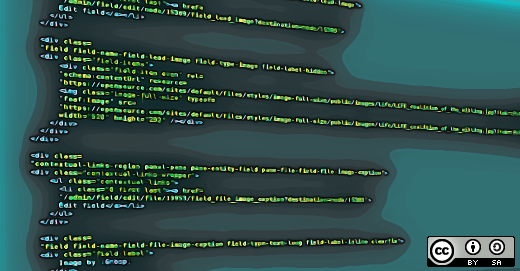用Python解析HTML
======

图片由Jason Baker为Opensource.com所作。
作为Scribus文档团队的长期成员,我随时了解最新的源代码更新,以便对文档进行更新和补充。 我最近在刚升级到Fedora 27系统的计算机上使用Subversion进行“checkout”操作时,对于文档下载所需要的时间我感到很惊讶,文档由HTML页面和相关图像组成。 我担心该项目的文档看起来比项目本身大得多,并且怀疑其中的一些内容是“僵尸”文档——不会再使用的HTML文件以及HTML中无法访问到的图像。
我决定为自己创建一个项目来解决这个问题。 一种方法是搜索未使用的现有图像文件。 如果我可以扫描所有HTML文件中的图像引用,然后将该列表与实际图像文件进行比较,那么我可能会看到不匹配的文件。
这是一个典型的图像标签:
```
 ```
我对第一组引号之间的部分很感兴趣,在src =之后。 寻找解决方案后,我找到一个名为[BeautifulSoup][1]的Python模块。 脚本的核心部分如下所示:
```
soup = BeautifulSoup(all_text, 'html.parser')
match = soup.findAll("img")
if len(match) > 0:
for m in match:
imagelist.append(str(m))
```
我们可以使用这个`findAll` 方法来挖出图片标签。 这是一小部分输出:
```
```
我对第一组引号之间的部分很感兴趣,在src =之后。 寻找解决方案后,我找到一个名为[BeautifulSoup][1]的Python模块。 脚本的核心部分如下所示:
```
soup = BeautifulSoup(all_text, 'html.parser')
match = soup.findAll("img")
if len(match) > 0:
for m in match:
imagelist.append(str(m))
```
我们可以使用这个`findAll` 方法来挖出图片标签。 这是一小部分输出:
```





 ```
到现在为止还挺好。我原以为下一步就可以搞定了,但是当我在脚本中尝试了一些字符串方法时,它返回了有关标记的错误而不是字符串的错误。 我将输出保存到一个文件中,并在[KWrite][2]中进行编辑。 KWrite的一个好处是你可以使用正则表达式(regex)来做“查找和替换”操作,所以我可以用`\n', all_text)
if len(match)>0:
for m in match:
imagelist.append(m)
```
它的一小部分输出如下所示:
```
images/cmcanvas.png" title="Context Menu for the document canvas" alt="Context Menu for the document canvas" />
```
到现在为止还挺好。我原以为下一步就可以搞定了,但是当我在脚本中尝试了一些字符串方法时,它返回了有关标记的错误而不是字符串的错误。 我将输出保存到一个文件中,并在[KWrite][2]中进行编辑。 KWrite的一个好处是你可以使用正则表达式(regex)来做“查找和替换”操作,所以我可以用`\n', all_text)
if len(match)>0:
for m in match:
imagelist.append(m)
```
它的一小部分输出如下所示:
```
images/cmcanvas.png" title="Context Menu for the document canvas" alt="Context Menu for the document canvas" />
```
我决定回到`src=`这一块。 一种方法是等待`s`出现,然后看下一个字符是否是`r`,下一个是`c`,下一个是否`=`。 如果是这样,那就匹配上了! 那么两个双引号之间的内容就是我所需要的。 这种方法的问题在于需要连续识别上面这样的结构。 一种查看代表一行HTML文本的字符串的方法是:
```
for c in all_text:
```
但是这个逻辑太乱了,以至于不能持续匹配到前面的`c`,还有之前的字符,更之前的字符,更更之前的字符。
最后,我决定专注于`=`并使用索引方法,以便我可以轻松地引用字符串中的任何先前或将来的字符。 这里是搜索部分:
```
index = 3
while index < linelength:
if (all_text[index] == '='):
if (all_text[index-3] == 's') and (all_text[index-2] == 'r') and (all_text[index-1] == 'c'):
imagefound(all_text, imagelist, index)
index += 1
else:
index += 1
else:
index += 1
```
我用第四个字符开始搜索(索引从0开始),所以我在下面没有出现索引错误,并且实际上,在每一行的第四个字符之前不会有等号。 第一个测试是看字符串中是否出现了`=`,如果没有,我们就会前进。 如果我们确实看到一个等号,那么我们会看前三个字符是否是`s`,`r`和`c`。 如果全都匹配了,就调用函数`imagefound`:
```
def imagefound(all_text, imagelist, index):
end = 0
index += 2
newimage = ''
while end == 0:
if (all_text[index] != '"'):
newimage = newimage + all_text[index]
index += 1
else:
newimage = newimage + '\n'
imagelist.append(newimage)
end = 1
return
```
我们正在给函数发送当前索引,它代表着`=`。 我们知道下一个字符将会是`"`,所以我们跳过两个字符,并开始向名为`newimage`的控制字符串添加字符,直到我们发现下一个`"`,此时我们完成了一次匹配。 我们将字符串加一个`换行`符添加到列表`imagelist`中并`返回`,请记住,在剩余的这个HTML字符串中可能会有更多图片标签,所以我们马上回到搜索循环的中间。
以下是我们的输出现在的样子:
```
images/text-frame-link.png
images/text-frame-unlink.png
images/gimpoptions1.png
images/gimpoptions3.png
images/gimpoptions2.png
images/fontpref3.png
images/font-subst.png
images/fontpref2.png
images/fontpref1.png
images/dtp-studio.png
```
啊,干净多了,而这只花费几秒钟的时间。 我本可以将索引前移7步来剪切`images/`部分,但我更愿意把这个部分保存下来,确保我没有切片掉图像文件名的第一个字母,这很容易用KWrite编辑成功- - 你甚至不需要正则表达式。 做完这些并保存文件后,下一步就是运行我编写的另一个脚本`sortlist.py`:
```
#!/usr/bin/env python
# -*- coding: utf-8 -*-
# sortlist.py
import os
imagelist = []
for line in open('/tmp/imagelist_parse4.txt').xreadlines():
imagelist.append(line)
imagelist.sort()
outfile = open('/tmp/imagelist_parse4_sorted.txt', 'w')
outfile.writelines(imagelist)
outfile.close()
```
这会读取文件内容,并存储为列表,对其排序,然后另存为另一个文件。 之后,我可以做到以下几点:
```
ls /home/gregp/development/Scribus15x/doc/en/images/*.png > '/tmp/actual_images.txt'
```
然后我需要在该文件上运行`sortlist.py`,因为`ls`方法的排序与Python不同。 我原本可以在这些文件上运行比较脚本,但我更愿意以可视方式进行操作。 最后,我成功找到了42个图像,这些图像没有来自文档的HTML引用。
这是我的完整解析脚本:
```
#!/usr/bin/env python
# -*- coding: utf-8 -*-
# parseimg4.py
import os
def imagefound(all_text, imagelist, index):
end = 0
index += 2
newimage = ''
while end == 0:
if (all_text[index] != '"'):
newimage = newimage + all_text[index]
index += 1
else:
newimage = newimage + '\n'
imagelist.append(newimage)
end = 1
return
htmlnames = []
imagelist = []
tempstring = ''
filenames = os.listdir('/home/gregp/development/Scribus15x/doc/en/')
for name in filenames:
if name.endswith('.html'):
htmlnames.append(name)
#print htmlnames
for htmlfile in htmlnames:
all_text = open('/home/gregp/development/Scribus15x/doc/en/' + htmlfile).read()
linelength = len(all_text)
index = 3
while index < linelength:
if (all_text[index] == '='):
if (all_text[index-3] == 's') and (all_text[index-2] == 'r') and
(all_text[index-1] == 'c'):
imagefound(all_text, imagelist, index)
index += 1
else:
index += 1
else:
index += 1
outfile = open('/tmp/imagelist_parse4.txt', 'w')
outfile.writelines(imagelist)
outfile.close()
imageno = len(imagelist)
print str(imageno) + " images were found and saved"
```
脚本名称为`parseimg4.py`,这并不能真实反映我陆续编写的脚本数量,包括微调的和大改的以及丢弃并重新开始写的。 请注意,我已经对这些目录和文件名进行了硬编码,但是总结起来很容易,要求用户输入这些信息。 同样,因为它们是工作脚本,所以我将输出发送到 `/tmp`目录,所以一旦重新启动系统,它们就会消失。
这不是故事的结尾,因为下一个问题是:僵尸HTML文件怎么办? 任何未使用的文件都可能会引用到前面比对方法没有提取到的图像。 我们有一个`menu.xml`文件作为联机手册的目录,但我还需要考虑TOC(译者注:TOC是table of contents的缩写)中列出的某些文件可能引用了不在TOC中的文件,是的,我确实找到了一些这样的文件。
最后我可以说,这是一个比图像搜索更简单的任务,而且开发的过程对我有很大的帮助。
### About the author
[][7] Greg Pittman - Greg是Kentucky州Louisville市的一名退休的神经学家,从二十世纪六十年代的Fortran IV语言开始长期以来对计算机和编程有着浓厚的兴趣。 当Linux和开源软件出现的时候,Greg深受启发,去学习更多只是,并实现最终贡献的承诺。 他是Scribus团队的成员。[更多关于我][8]
--------------------------------------------------------------------------------
via: https://opensource.com/article/18/1/parsing-html-python
作者:[Greg Pittman][a]
译者:[Flowsnow](https://github.com/Flowsnow)
校对:[校对者ID](https://github.com/校对者ID)
本文由 [LCTT](https://github.com/LCTT/TranslateProject) 原创编译,[Linux中国](https://linux.cn/) 荣誉推出
[a]:https://opensource.com/users/greg-p
[1]:https://www.crummy.com/software/BeautifulSoup/
[2]:https://www.kde.org/applications/utilities/kwrite/
[7]:https://opensource.com/users/greg-p
[8]:https://opensource.com/users/greg-p
 ```
我对第一组引号之间的部分很感兴趣,在src =之后。 寻找解决方案后,我找到一个名为[BeautifulSoup][1]的Python模块。 脚本的核心部分如下所示:
```
soup = BeautifulSoup(all_text, 'html.parser')
match = soup.findAll("img")
if len(match) > 0:
for m in match:
imagelist.append(str(m))
```
我们可以使用这个`findAll` 方法来挖出图片标签。 这是一小部分输出:
```
```
我对第一组引号之间的部分很感兴趣,在src =之后。 寻找解决方案后,我找到一个名为[BeautifulSoup][1]的Python模块。 脚本的核心部分如下所示:
```
soup = BeautifulSoup(all_text, 'html.parser')
match = soup.findAll("img")
if len(match) > 0:
for m in match:
imagelist.append(str(m))
```
我们可以使用这个`findAll` 方法来挖出图片标签。 这是一小部分输出:
```





 ```
到现在为止还挺好。我原以为下一步就可以搞定了,但是当我在脚本中尝试了一些字符串方法时,它返回了有关标记的错误而不是字符串的错误。 我将输出保存到一个文件中,并在[KWrite][2]中进行编辑。 KWrite的一个好处是你可以使用正则表达式(regex)来做“查找和替换”操作,所以我可以用`\n
```
到现在为止还挺好。我原以为下一步就可以搞定了,但是当我在脚本中尝试了一些字符串方法时,它返回了有关标记的错误而不是字符串的错误。 我将输出保存到一个文件中,并在[KWrite][2]中进行编辑。 KWrite的一个好处是你可以使用正则表达式(regex)来做“查找和替换”操作,所以我可以用`\n